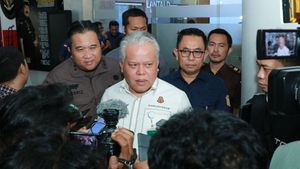JAKARTA - European aviation safety regulators on Thursday ordered checks on Airbus A350-1000 jet engines, following engine fires on Cathay Pacific passenger jet flights.
The European Union Aviation Safety Agency (EASA) said it was acting to prevent similar incidents after consulting with regulators and accident investigators in Hong Kong, where Cathay is headquartered, as well as Airbus and engine supplier Rolls-Royce.
"This action is a precautionary measure, based on information received from the initial investigation of the recent Cathay Pacific serious incident and the airline's findings in subsequent inspections," EASA Executive Director Florian Guilleret said in a statement.
EASA also confirmed that the failure of the hose in the fuel system had caused a fire that would soon be handled by the crew.
"Serious incidents" are terms of in-flight investigation which means there is a high probability of an accident.
"We will continue to closely follow all the information that will be available through ongoing safety investigations," Guilleret said.
The move affects the larger double-engine A350 model, A350-1000, which represents 15 percent of the A350 or 86 jet fleet. The smaller and widely sold A350-900 are unaffected.
In an emergency directive issued late Thursday, EASA gave airlines between three and 30 days to carry out visual checks and measurements at the fuel hose but did not ask for these parts removed for the work, unless they were found damaged.
That doesn't include the machine Cathay has checked.
Rolls-Royce and Airbus said earlier they were working closely with the authorities to comply with the planned directives. Rolls Royce said the focus was to minimize short-term disruption.
"We apologize to those who may be affected", he added.
Previously, A350-1000 aircraft and XWB-97 engines had been in the spotlight, since jets bound for Zurich were forced to return to Hong Kong on Monday after engine problems, which were then traced to fuel leaks.
Preliminary investigations have revealed that a hose between a manifold and a fuel injection nozzle was leaked, sources said on Wednesday. And, Hong Kong-led investigations now have to determine whether this is the cause or result of the incident.
EASA said the fire had caused heat damage to the engine house, including the drains used to push back on landing.
"This condition, if not detected and repaired, can, combined with additional failures, cause more severe engine fires and result in damage to aircraft," he said.
Reuters has reported earlier that EASA's actions are likely to involve visual inspections with a progressive deadline - a relatively light maintenance task.
However, by ordering an inspection, EASA ignored some of the manufacturer's efforts to circumvent disturbing actions on the entire fleet based on their own technical analysis, the source said.
SEE ALSO:
Unless there is new evidence, they tend not to recommend examinations around the world, but the final decision is in the hands of regulators, sources told Reuters on Wednesday.
Due to the very complicated nature of aircraft and engines, manufacturers usually do a lot of technical basic work in preparing regulatory instructions and playing an important role in global monitoring of operating fleets.
However, regulators can ignore their recommendations, order their own checks, and they face mounting pressure to appear to be acting independently after tightening global safety surveillance following the Boeing safety crisis.
The English, Chinese, Japanese, Arabic, and French versions are automatically generated by the AI. So there may still be inaccuracies in translating, please always see Indonesian as our main language. (system supported by DigitalSiber.id)


















